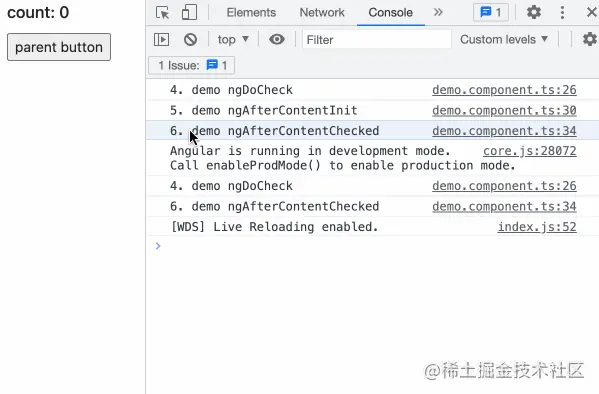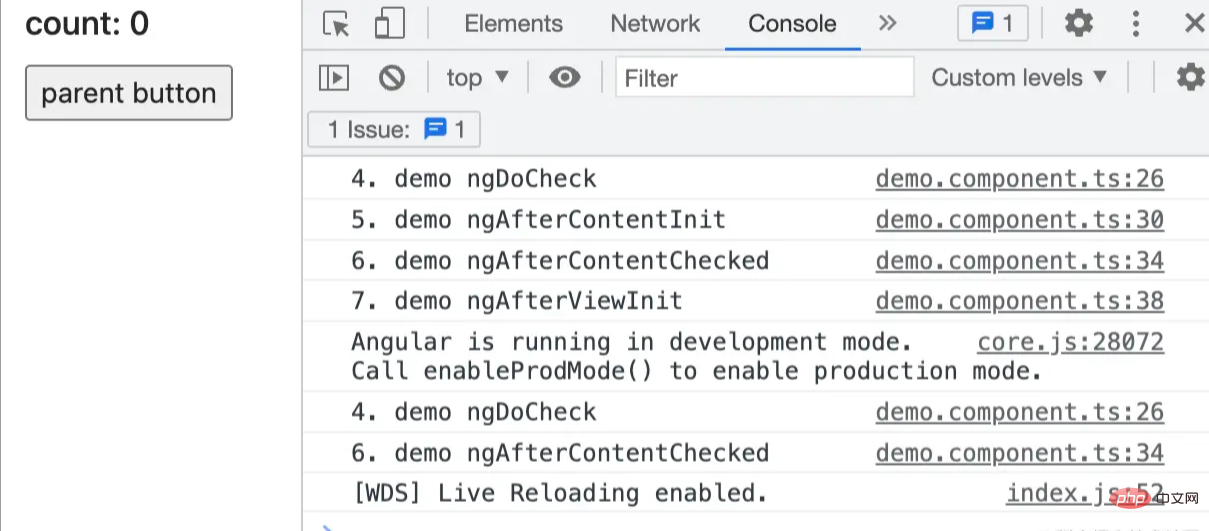一文聊聊Angular中的生命週期
- 青灯夜游轉載
- 2022-05-06 10:58:034028瀏覽
使用angular進行開發時,避免不了需要接觸生命週期,以下這篇文章就來帶大家一起聊聊Angular中的生命週期,希望對大家有幫助!

接觸過 react 和 vue 開發的讀者應該對生命週期這個概念不陌生。我們在使用 angular 開發的過程中,是避免不了的。 【相關教學推薦:《angular教學》】
#元件從開始建立到銷毀的過程中,會經歷過一系列的階段。這就是一個生命週期,這些階段對應著應用程式提供的 lifecycle hooks。
那麼,在 angular 中,這些 hooks 都有哪些呢?了解它們,對你編寫程式應該在哪裡寫,很重要。
angular 中,生命週期執行的順序如下:
- constructor 【常用,不算钩子函数,但是很重要】 - ngOnChanges【常用】 - ngOnInit【常用】 - ngDoCheck - ngAfterContentInit - ngAfterContentChecked - ngAfterViewInit【常用】 - ngAfterViewChecked - ngOnDestroy【常用】
為了解說和驗證,我們用angular-cli 產生一個 demo 項目。
constructor
在 es6 中的 class 初始化物件的時候,constructor 會立即被呼叫。
class Person {
constructor(name) {
console.log('be called')
this.name = name;
}
}
let jimmy = new Person('jimmy'); // be calledangular 的元件本身就是要匯出一個類別。當這個元件被 new 起來的時候,會取得 constructor 中的預設的值。
ngOnChanges
當我們有外部參數改變的時候,我們就會執行ngOnChanges,也就是說元件中有@Input 所綁定的屬性值改變的時候呼叫。
簡單說,父元件綁定子元件中的元素,會觸發這個鉤子函數,可以多次出發。這在下面的 ngOnInit 總是會介紹。
ngOnInit
這個方法呼叫的時候,表示元件已經初始化成功。在第一次 ngOnChanges() 完成之後調用,且只調用一次。
// app.component.ts
export class AppComponent implements OnInit, OnChanges {
constructor() {
console.log('1. constructor')
}
ngOnChanges() {
console.log('2. ngOnChanges')
}
ngOnInit() {
console.log('3. ngOnInit')
}
}列印的資訊如下:

咦?怎麼沒有列印 ngOnChanges 中的鉤子函數資訊呢?
上面已經說過了,需要觸發條件 @Input 的屬性值改變的時候。讓我們來修改一下:
<!-- app.component.html --> <div> <app-demo></app-demo> </div>
// app.component.ts // AppComponent 类中添加属性 public count:number = 0;
<!-- demo.component.html -->
<h3>count: {{ count }}</h3>// demo.component.ts
export class DemoComponent implements OnInit, OnChanges {
@Input()
public count: number;
constructor() {
console.log('1. demo constructor')
}
ngOnChanges() {
console.log('2. demo ngOnChanges')
}
ngOnInit() {
console.log('3. demo ngOnInit')
}
}
當透過@Input 將值傳遞給子元件demo 的時候,就會觸發demo 元件中的ngOnChanges。
當 @Input 傳遞的屬性改變的時候,可以多次觸發 demo 元件中的 ngOnChanges 鉤子函數。
<!-- app.component.html --> <div> <app-demo [count]="count"></app-demo> <button (click)="parentDemo()">parent button</button> </div>
// app.component.ts
parentDemo() {
this.count++;
}
ngDoCheck
當變化偵測發生的時候,觸發該鉤子函數。
這個鉤子函數,緊接在每次執行變更偵測時候 ngOnChanges 和第一次執行執行變更偵測 ngOnInit 後面呼叫。
// demo.component.ts
ngDoCheck() {
console.log('4. demo ngDoCheck')
}

這個鉤子函數呼叫得比較頻繁,使用成本比較高,謹慎使用。
一般使用ngOnChanges 來偵測變動,而不是ngDoCheck
#ngAfterContentInit
##當把外部的內容投影到內部元件,第一次呼叫ngDoCheck 之後呼叫ngAfterContentInit,而且只呼叫一次。
// demo.component.ts
ngAfterContentInit() {
console.log('5. demo ngAfterContentInit');
}

#ngAfterContentChecked 鉤子函數在每次ngDoCheck 後呼叫.
// demo.component.ts
ngAfterContentChecked() {
console.log('5. demo ngAfterContentChecked');
}

ngAfterContentChecked 之後調用,只調用一次。
DOM 節點比較合理
// demo.compoent.ts
ngAfterViewInit() {
console.log('7. demo ngAfterViewInit');
}

ngAfterViewinit 後調用,和在每次 ngAfterContentChecked 之後調用,也就是在每次 ngDoCheck 之後調用。
// demo.component.ts
ngAfterViewChecked() {
console.log('8. ngAfterViewChecked')
}

ngOnDestroy
组件被销毁时候进行的操作。
在这个钩子函数中,我们可以取消订阅,取消定时操作等等。
<!-- app.component.html --> <app-demo [count]="count" *ngIf="showDemoComponent"></app-demo> <button (click)="hideDemo()">hide demo component</button>
// app.component.ts
public showDemoComponent: boolean = true;
hideDemo() {
this.showDemoComponent = false
}// demo.component.ts
ngOnDestroy() {
console.log('9. demo ngOnDestroy')
}
PS: 不知道读者有没有发现,调用一次的钩子函数都比较常用~
【完】
更多编程相关知识,请访问:编程入门!!
以上是一文聊聊Angular中的生命週期的詳細內容。更多資訊請關注PHP中文網其他相關文章!

